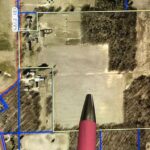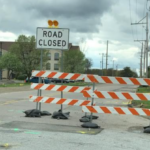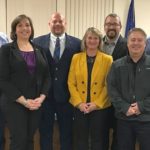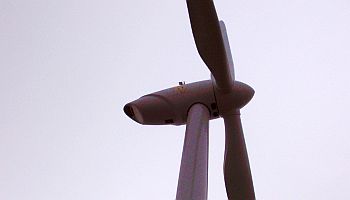 01/06/12 The Tippecanoe Valley School Corporation made Indiana history in November of last year after being the first school in the state to install a wind turbine. Superintendent Brett Boggs said, “Since September three years ago, we had spent a lot of time studying it.”
01/06/12 The Tippecanoe Valley School Corporation made Indiana history in November of last year after being the first school in the state to install a wind turbine. Superintendent Brett Boggs said, “Since September three years ago, we had spent a lot of time studying it.”
 On November 15, 2011, the blades began turning on the 322-foot high, 900 kW, PowerWind turbine that is expected to provide up to 70 percent of the power needed to operate both the middle school and senior high school. The turbine has a hub that reaches approximately 225 feet and 90 foot blades. Boggs said, “It will generate a significant amount of electricity.” Groundbreaking for the project was held on May 31.
On November 15, 2011, the blades began turning on the 322-foot high, 900 kW, PowerWind turbine that is expected to provide up to 70 percent of the power needed to operate both the middle school and senior high school. The turbine has a hub that reaches approximately 225 feet and 90 foot blades. Boggs said, “It will generate a significant amount of electricity.” Groundbreaking for the project was held on May 31.
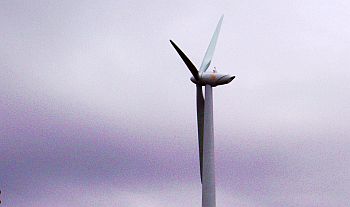 Boggs said the project will help the school district compensate for decreases in state funding while, at the same time, reduce expenditures without diminishing programs for students. He said, “It will free up money in the general fund.”
Boggs said the project will help the school district compensate for decreases in state funding while, at the same time, reduce expenditures without diminishing programs for students. He said, “It will free up money in the general fund.”
According to reports, Kosciusko REMC joined with the school corporation and the design-builder, Performance Services, to develop the unique solution.
TVSC was awarded $2.3 million in Clean Renewable Energy bonds. The remaining $300,000 needed for the project is being covered by a 15-year construction bond. According to Boggs, there is a 12-15 year payout on the project. He said, “The life of the equipment is 20-25 years.” Many reports indicate that the turbine could last 30 years.
The turbine is monitored 24 hours a day by the German manufacturer and Broadwind, an Illinois-based company, which is responsible for maintaining it. Boggs said that over the holidays the equipment was shut down remotely to fix a motor for the pump that helps to cool the generator.
The turbine went through two phases as it was commissioned. The first phase had the turbine consuming power from the grid. As power is generated, it flows backward from the grid through the turbine generator. That action essentially converts the generator into an electric motor. During the second phase, the turbine produces power to the grid. Then three speeds of rotational testing occur with the commissioning sequences completed at each speed. The testing phase also allowed the blade rotation to be checked.
Boggs said, “It is pretty quiet although it is only located some 300-400 yards from the offices. He said, “On a really sunny day, if you look directly at the blades there is a little bit of a flicker.” He said the blades are turning most of the time.
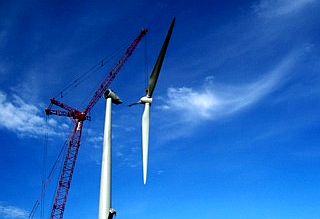 Boggs said there was absolutely no opposition to the project from the community. He said, “There were some legitimate questions that we answered, but no one expressed opposition.”
Boggs said there was absolutely no opposition to the project from the community. He said, “There were some legitimate questions that we answered, but no one expressed opposition.”
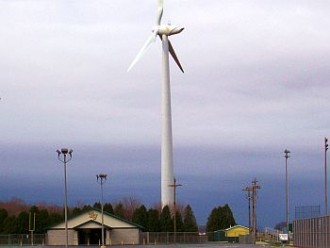 The school corporation could lease space on the tower to generate income. Boggs said that cell phone companies could lease space up to 120 feet in the air and still not be in the path of the blades.
The school corporation could lease space on the tower to generate income. Boggs said that cell phone companies could lease space up to 120 feet in the air and still not be in the path of the blades.
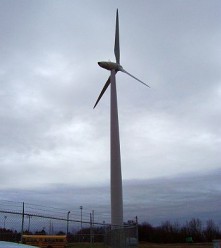 Boggs said they have gotten a lot of positive feedback on the project. He said, “It is an opportunity for us to set a good example to our students.” An extra bonus is the curriculum that is provided for students on wind energy that can be used in the classrooms.
Boggs said they have gotten a lot of positive feedback on the project. He said, “It is an opportunity for us to set a good example to our students.” An extra bonus is the curriculum that is provided for students on wind energy that can be used in the classrooms.
Boggs said information on the usage can be found on the schools’ website under “Digital Dashboard”.
Carol Anders Correspondent










